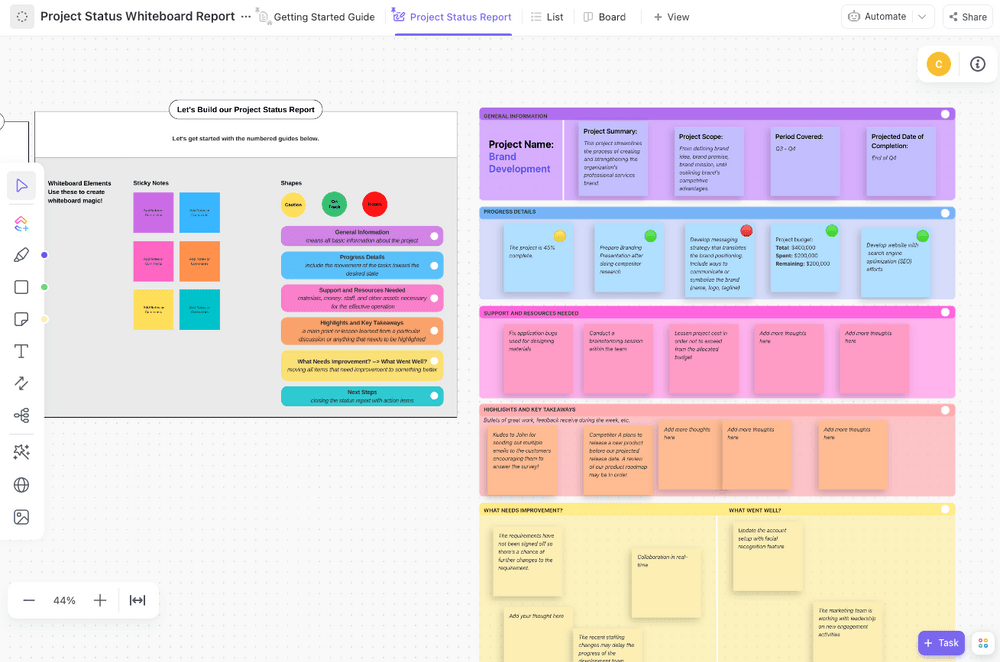بصفتك مدير مشروع، قد تشعر بأنك بطل مجهول. فأنت لا تدير الفرق والمهام والميزانيات والجداول الزمنية فحسب، بل أنت مسؤول أيضاً عن عرض التقدم المحرز على أصحاب المصلحة.
لا يوجد ضغط، أليس كذلك؟
بدلاً من التعرق عندما يحين الوقت لتعرض على الرئيس التنفيذي ما عملت بجد من أجله، قم بإنشاء تقرير حالة المشروع. يلخص هذا التقرير العمل الذي تم إنجازه حتى الآن والخطوات التالية - وهو منقذ حقيقي لتقرير الحالة الأسبوعي في اجتماعات مديري المشاريع.
سنشرح في هذا الدليل ما هو تقرير حالة المشروع، وما يجب تضمينه فيه، وكيفية إنشاء تقارير أفضل. كما سنقدم بعض الأمثلة والنماذج لتقرير حالة إدارة المشروع لتقليل الوقت الذي تقضيه في إنشاء تقارير الحالة.
لأن الأمر في نهاية اليوم يتعلق بالعمل بذكاء وليس بجهد أكبر. 💪
ما هو تقرير حالة المشروع؟
تقرير حالة المشروع هو وثيقة مفصلة تقدم أصحاب المصلحة الرئيسيين لمحة عامة عن الوضع الحالي لمشروع مهم. يقوم مديرو المشاريع عادةً بإعداد هذه التقارير بشكل منتظم ومشاركتها مع أعضاء الفريق أو الإدارة أو العملاء.
بدلًا من إنجاز المهام بسرعة فائقة، فإن إنشاء تقرير المشروع ق يجبرك على التوقف والتفكير في كيفية إكمال المشاريع. أنت تنظر إلى المشاريع بأثر رجعي واستباقي، مما يبسط دورة حياة المشروع.

قم بتقسيم مشاريعك في عرض المجلس لمعرفة الحالة والتقدم والإمكانات بسهولة لمحة سريعة عن الاختناقات لا يضر أن التقرير القوي سيجعل أصحاب المصلحة سعداء أيضًا.
الهدف هنا هو إبقاء الجميع على علم بتقدم المشروع. إذا كنت تقوم بعمل في مواجهة العميل، فإن حالة المشروع تؤكد التقارير للعملاء أنك تعمل بجد في العمل
وإذا قمت بإعداد تقارير حالة قوية لمراجعاتك الأسبوعية، فلا تتفاجأ إذا أعطاك رئيسك صفعة قوية على ظهرك. 🤩
## كيفية كتابة تقرير حالة المشروع مع أمثلة مفيدة
في هذه المرحلة، قد تكون لديك فكرة عما يجب تضمينه في تقرير حالة المشروع. ولكن كيف يمكنك وضع كل ذلك معًا؟
ليست هناك حاجة لصنع تقرير المشروع الخاص بك بنفسك. ما عليك سوى اتباع هذه الخطوات - واتباع الأمثلة والقوالب التي أثبتت جدواها - لإنشاء تقارير حالة المشروع في وقت قصير جداً. ⏲️
الخطوة 1: فهم احتياجات أصحاب المصلحة في المشروع
ليست هناك حاجة لإضافة طوفان من البيانات إلى تقارير حالة مشروعك. كل ما تحتاجه هو المعلومات الأكثر أهمية لأصحاب المصلحة في المشروع.
اعرف جمهورك المستهدف. ما الذي يحتاجون إلى رؤيته؟ ما الذي يهتمون به بالفعل؟ 👀
على سبيل المثال، إذا كنت مبرمجًا ولكن أصحاب المصلحة لديك هم مدراء غير تقنيين، فهذا ليس الوقت المناسب لشرح تعقيدات جافا سكريبت. لا يهتم راعي مشروعك إلا بالميزات والوظائف، لذا قم بإنشاء تقرير هادف وخالٍ من المصطلحات يساعدهم على اتخاذ القرارات بسرعة أكبر.
الخطوة 2: قم بجدولته بانتظام
تقارير المشروع ليست شيئًا تقوم بإنشائه عندما تشعر بالرغبة في ذلك. يجب أن يكون هذا جزءًا منتظمًا من سير عملك لفهم صحة المشروع بشكل عام. أضفها إلى إدارة المهام الحل حتى لا تنسى.
من الجيد أيضًا إعداد دعوة متكررة للتقويم مع جميع أصحاب المصلحة الرئيسيين حتى تتمكن من مراجعة تقرير الحالة على أساس ثابت.
الخطوة 3: ابدأ بجمع البيانات
يجب أن يكون كل تقرير حالة مشروع فريد من نوعه. اسحب البيانات الأكثر صلة من أنظمتك لتحديث التقرير قبل مراجعته مع الفريق.
يمكنك توصيل بيانات المشروع يدويًا، لكننا على استعداد للمراهنة على أنك مشغول جدًا لذلك. قم بإنشاء لوحة تحكم مخصصة لتتبع كل شيء حتى لا تفقد عقلك في كل مهمة ومشروع وشخص.

إنشاء لوحات معلومات مخصصة في ClickUp للحصول على نظرة عامة عالية المستوى لجميع أعمالك
ليس عليك القيام بذلك بمفردك أيضاً. اطلب من أعضاء فريقك المساهمة برؤاهم. برنامج إدارة المشاريع لا تروي القصة الكاملة دائمًا، خاصةً مع البيانات النوعية. قم بدعوة فريقك لمشاركة الأفكار بحلول تاريخ معين حتى تتمكن من تضمينها في التقرير.
الخطوة 4: ابدأ من نموذج تقرير حالة المشروع الشامل
يقوم بعض مديري المشاريع بإنشاء تقارير من جداول بيانات Excel أو مستندات Google، ولكن ذلك يتطلب الكثير من النسخ واللصق. بدلاً من ذلك، أنشئ تقريرًا من البيانات الموجودة في نظام إدارة المشروع الخاص بك بحيث يمكن النقر عليه والانطلاق منه.
بالطبع، تحتاج إلى استخدام قالب تقرير حالة المشروع بناءً على نوع المشروع الذي تعمل عليه. سيكون لمؤسستك مراوغاتها الخاصة، ولكن من الجيد أن تأخذ في الحسبان الفروق الدقيقة لأنواع المشاريع هذه:
- تقارير الحالة اليومية: يستغرق إنشاء التقارير اليومية الكثير من الجهد، لذا سيوفر لك القالب الكثير من الوقت. نظرًا لأنه من المحتمل أن تكون التقارير اليومية قصيرة وملائمة قدر الإمكان. ربما ستحتاج إلى تعديلها في الوقت الفعلي حتى لا يفوتك أي شيء
- تقارير الحالة الأسبوعية: من المحتمل أن يختار فريقك نفس اليوم من كل أسبوع للدردشة حول تقدم المشروع. تُعد تقارير حالة المشروع الأسبوعية شائعة في المشاريع المكثفة التي تواجه العملاء، لذا انتبه كثيرًا لجدولك الزمني وميزانيتك وخطواتك التالية
- تقارير الحالة الشهرية: هذه التقارير شائعة إذا كنت تقوم بمشروع تسويقي حيث تحتاج إلى وقت بين تقارير الحالة لتتبع مؤشرات الأداء الرئيسية والمقاييس
- تقارير الحالة الفصلية: اجعل التقارير الفصلية عالية المستوى. من السهل الدخول في الأعشاب الضارة عندما يكون لديك بيانات تكفي لثلاثة أشهر للنظر فيها، ولكن ركز فقط على أهم النتائج
قالب تقرير حالة مشروع ClickUp
إن فهم تكرار التقرير يجعل اختيار القالب أسهل بكثير. من هنا، يكون الأمر سهلاً مثل توصيل بياناتك في قالب يحتوي على أقسام ورسومات وترميز لوني رائع جاهز للعمل.
على سبيل المثال، قالب قالب تقرير حالة مشروع ClickUp هو في الواقع لوحة بيضاء يمكنك تحويلها إلى تقرير حالة بنقرات قليلة فقط.
قالب تقرير حالة المشروع من ClickUp في السبورات البيضاء
استخدم القالب لـ
- تنظيم المشاريع حسب تصنيفات أو فلاتر أو مهام معينة
- إنشاء المخططات والرسوم البيانية الصحية للمشروع تلقائيًا
- مشاركة المهام، وتواريخ الاستحقاق، وتفاصيل الميزانية مع الفريق وأصحاب المصلحة الرئيسيين
يأتي قالب تقرير حالة المشروع مع حالات وحقول وعروض قابلة للتخصيص حتى تتمكن من جعله خاصاً بك. بدلاً من التنقل بين برنامج إدارة المشروع ومستند تقرير الحالة الخاص بك، يمكنك الاحتفاظ بكل شيء داخل منصة ClickUp لتسريع الوقت المستغرق في إنشاء التقارير بشكل كبير.
هذا مكسب شامل، أليس كذلك؟ 🏆
الخطوة 5: التحديث أثناء التنقل
تقرير حالة المشروع هو وثيقة حية. يجب أن تتغير المعلومات الواردة فيه بشكل منتظم لتعكس الحالة الحالية للمشروع، ولكن لا بأس من تغيير القالب الخاص بك.
اجمع التعليقات من جميع أصحاب المصلحة لمعرفة ما إذا كانوا يجدون التحديثات مفيدة. إذا كانوا لا يعتقدون أن التقرير المرحلي مفيد، قد تحتاج إلى إضافة أقسام أو اقتطاعها.
لكن لا تأخذ الأمر على محمل شخصي: إذا كانت هذه التغييرات تجعل التقرير أكثر جاذبية، فإن الأمر يستحق تعديل عملية إعداد التقارير.
## فوائد استخدام تقرير حالة المشروع في إدارة المشاريع
بالتأكيد، يمكنك تجميع بعض نقاط الحديث قبل اجتماعك التالي لتسجيل الوصول. لكن ذلك لا يبدو احترافيًا مثل تقرير مناسب عن تقدم المشروع.
باستخدام القالب الصحيح أو طريقة عرض المشروع الصحيحة، لا يستغرق الأمر وقتًا على الإطلاق لإنشاء تقرير حالة قوي لإدارة المشروع. فببضع نقرات فقط، يمكنك أنت أو مديرو مشروعك إنشاء مستند عالي الجودة يأتي مع مجموعة من الفوائد.
1. اجعل أصحاب المصلحة لديك سعداء
هل رئيسك في العمل متلهف للحصول على تحديثات الحالة؟ هل لديك عميل متلهف للحصول على نتائج؟
تهدئ تقارير حالة المشروع من قلق العملاء القلقين وتظهر لرئيسك أنك جاد في عملك. إنها تقارير قوية أداة قوية لإدارة المشروع التي تُحدِّث الجميع على معالم المشروع والتقدم العام الذي أحرزته.
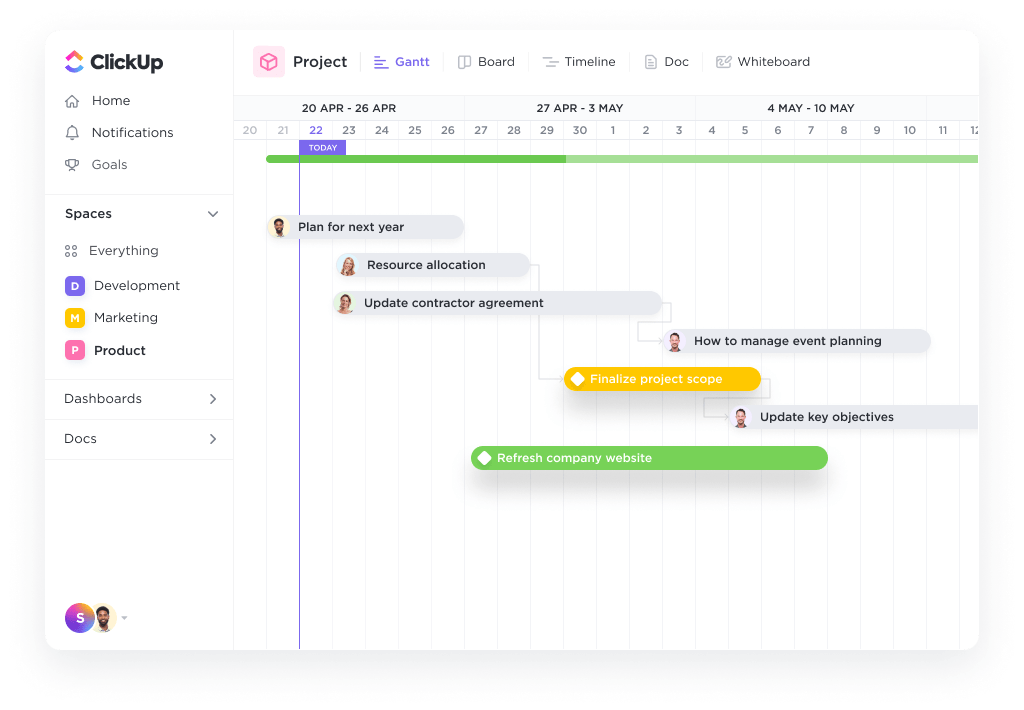
تصور المعالم الرئيسية للمشروع باستخدام عرض جانت في ClickUp
بالإضافة إلى ذلك، يمكنك استخدام تقرير حالة المشروع الرائع كأداة لتتبع الأداء. وهذا لا يوضح فقط كيف يسير المشروع فحسب، بل يبرر أيضًا جهود كل فرد في فريقك.
2. تعزيز تعاون الفريق
العمل الجماعي يحقق الحلم، ولكن إدارة مجموعة كبيرة أمر معقد. لحسن الحظ، فإن تقارير حالة المشروع تجعل الجميع على نفس الصفحة وتعزز تعاون الفريق .
بدلاً من السماح لمهام المشروع بأن تطفو بعيدًا في الأثير، فإن تقرير الحالة يمنح الجميع عناصر عمل واضحة . يوفر الهيكل والمساءلة لتحفيز فريق مشروعك على القيام بأفضل ما لديهم من عمل. 🙌
راقب تحديثات المشروع، وقم بإدارة مهام سير العمل، وتعاون مع الفريق، كل ذلك من مساحة عمل ClickUp الخاصة بك
بالإضافة إلى ذلك، يمكن للتقارير المنتظمة أن ترفع معنويات الفريق. إن تصور النجاح والمراحل المكتملة يضع التركيز على إنجازات فريقك بدلاً من التركيز فقط على المهام القادمة. وتُظهر البيانات الحديثة أن التقدير يحسن من رفاهية الموظفين
3. تسريع الجداول الزمنية للمشروع
لا أحد يحب التأخير في المشروع. على الرغم من أنك لا تستطيع تجنب جميع العثرات، إلا أن تقارير حالة المشروع المنتظمة تبقي فريقك مسؤولاً عن الجدول الزمني للمشروع.
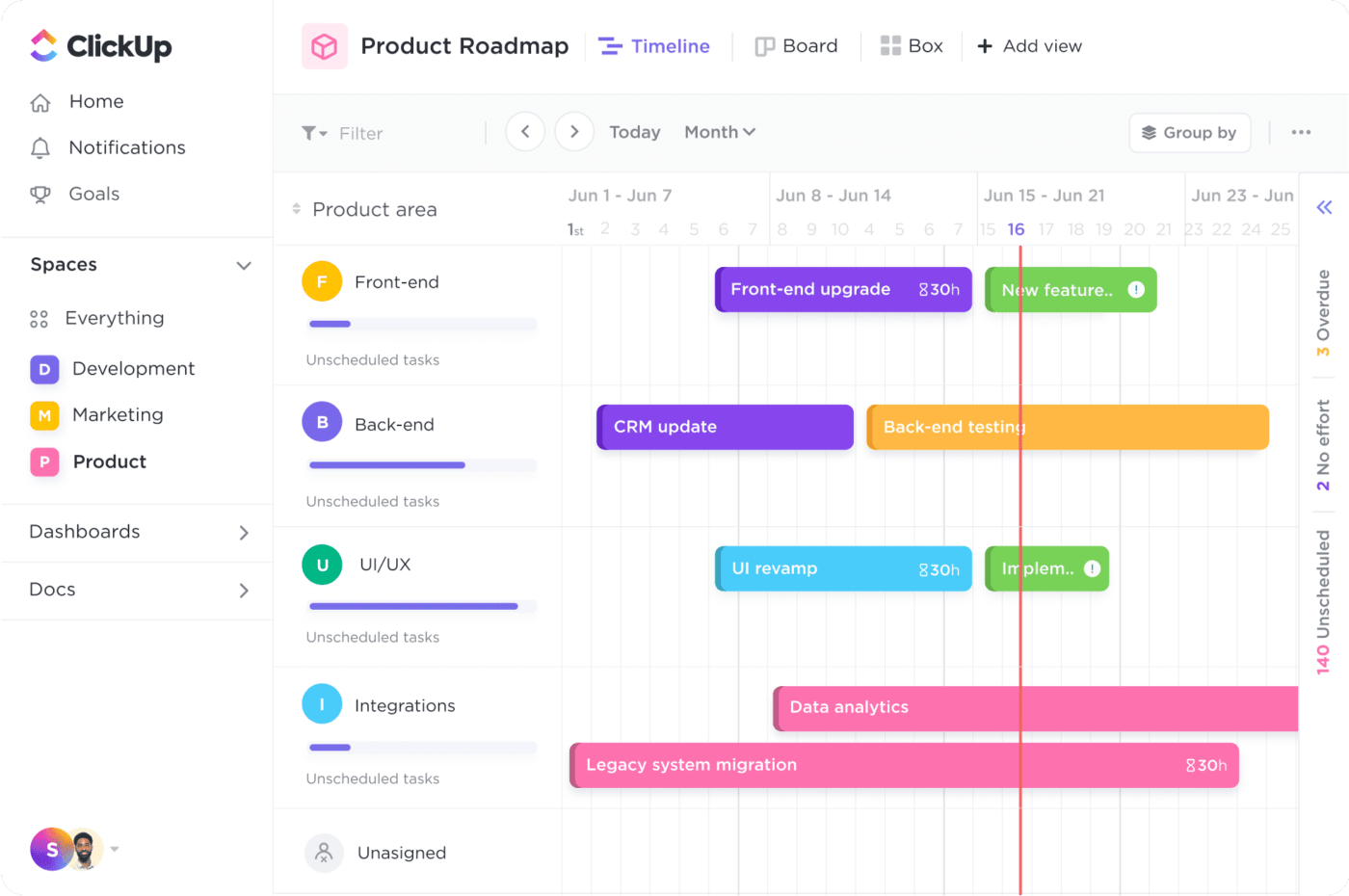
قم بجدولة مشاريع متعددة، وإدارة التبعيات، وتحديد أولويات كل شيء في الجدول الزمني المخصص لمشروعك باستخدام طريقة عرض الجدول الزمني في ClickUp
توفر تقارير الحالة هيكلاً ضرورياً للغاية لعملية إدارة المشروع، مما يقلل من الوقت والجهد الضائعين. احتفظ بعلامات تبويب على جدولك الزمني باستخدام متتبع المشروع .
من هناك، يكون الأمر سهلاً مثل تصدير بياناتك لتزويد الجميع بتقرير متعمق ببضع نقرات فقط.
4. تحديد المشكلات في أسرع وقت ممكن تحديد المخاطر يحافظ على
ميزانية المشروع في الخط والمهام في الوقت المحدد - شريطة أن تكتشف المخاطر المحتملة في وقت مبكر بما فيه الكفاية. يجب أن تتضمن تقارير حالة إدارة المشروع قسمًا عن التحديات والعوائق حتى تتمكن من مناقشتها مع فريق المشروع.
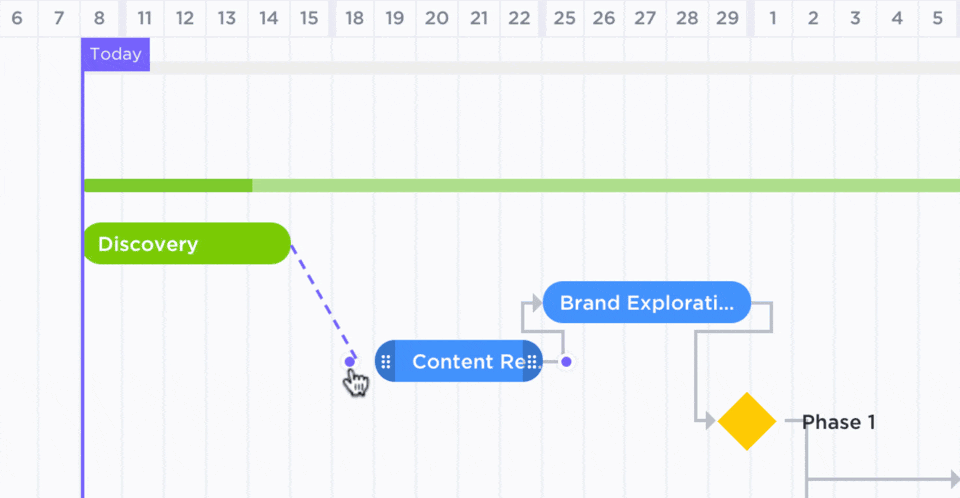
إظهار العلاقات بين المهام والمهام المتطلبة في طريقة عرض جانت في ClickUp
يمنحك هذا فرصة للتجمع في مراقبة المهام والتوصل إلى حل للمهام المعرضة للخطر في أسرع وقت ممكن. ⚒️
بدلاً من التزاحم للتعامل مع المهام الجانبية غير المتوقعة، فإن توقع المشكلات يحافظ على تركيز فريقك وإنتاجيته. إذا كنت تعمل في مجال شديد التنظيم، فيمكن أن يساعدك ذلك في إدارة المخاطر، وهو ما سيحبه قسم الشؤون القانونية لديك.
5. اتخاذ قرارات أفضل
تتطلب إدارة المشروع في بعض الأحيان اتباع حدسك، ولكن 9 مرات من أصل 10، تحتاج إلى تبرير قراراتك بالبيانات. توفر تقارير الحالة المنتظمة معلومات كافية عن المشروع لدعم اتخاذ القرارات المستندة إلى البيانات.
تتضمن تقارير حالة المشروع مقاييس مهمة تخبرك ما إذا كان الوقت قد حان لتصحيح المسار أو إذا كان كل شيء على ما يرام. حدد نجاح المشروع بمقاييس مثل:
- الإنجاز في الوقت المحدد
- تواريخ العمل
- الوقت المستغرق
- نسبة الإنجاز
- رضا العميل
- معدل الخطأ
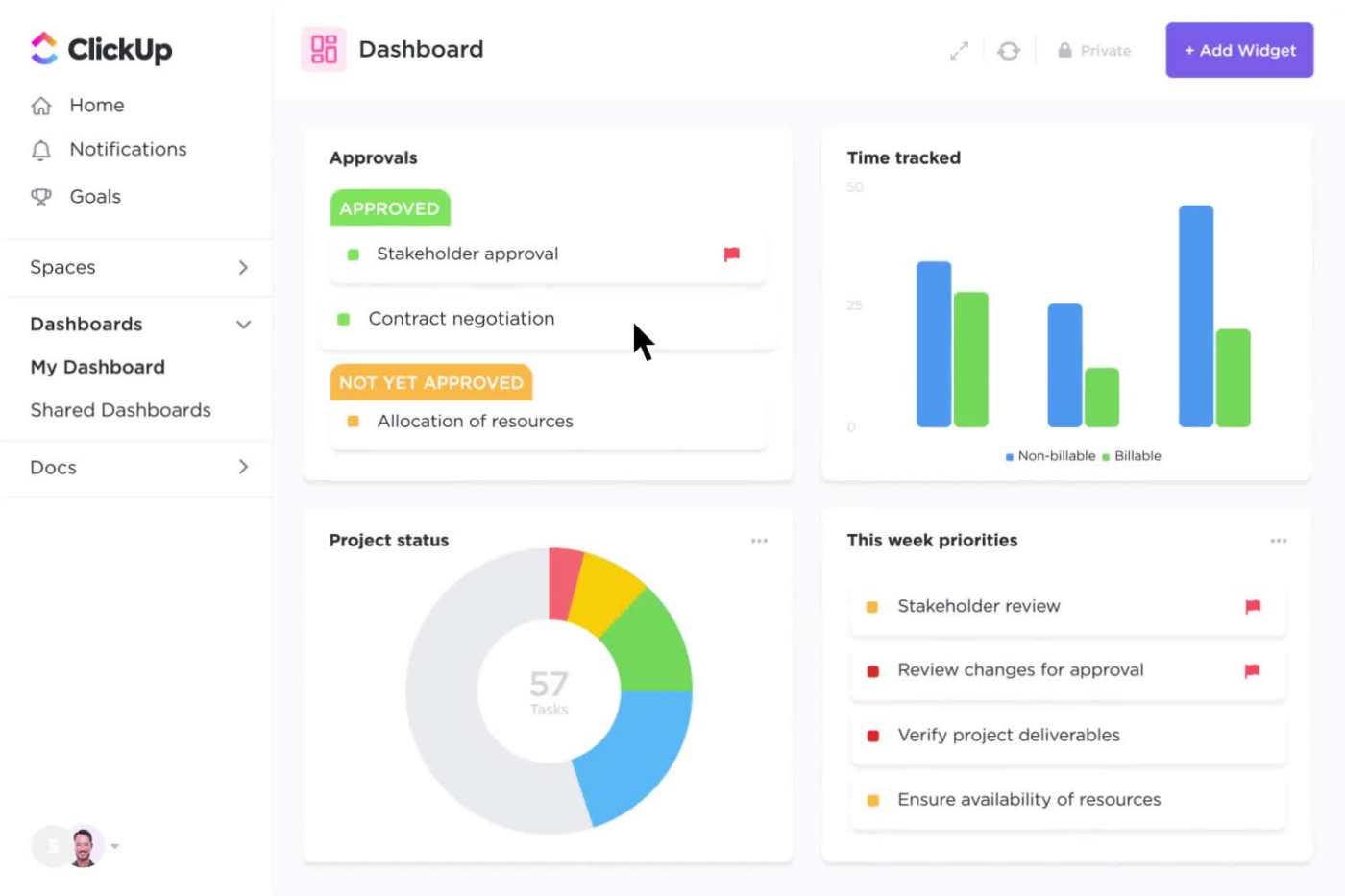
إنشاء لوحات معلومات مخصصة في ClickUp للحصول على نظرة عامة عالية المستوى لجميع أعمالك
من الناحية المثالية، يجب أن تنظر إلى البيانات من فترات إعداد التقارير السابقة لتحديد الاتجاهات. على سبيل المثال، إذا كنت تتجاوز الميزانية بشكل متكرر في أنواع معينة من المشاريع (أو مع عملاء معينين)، فقد تحتاج إلى زيادة عرضك في المشروع التالي - أو العثور على بعض الفرص الجادة لتوفير التكاليف.
6. تحسين التواصل
سواء كنت تتحدث مع رئيسك أو عميلك أو أعضاء فريقك، فإن تقرير حالة المشروع يدعم التواصل الشفاف. فهو لا يقوم فقط بتنسيق جميع تفاصيل المشروع بطريقة سهلة الهضم مع ألوان جميلة، ولكنه يشجع فريقك أيضًا على التواصل بشكل متكرر. 🌻
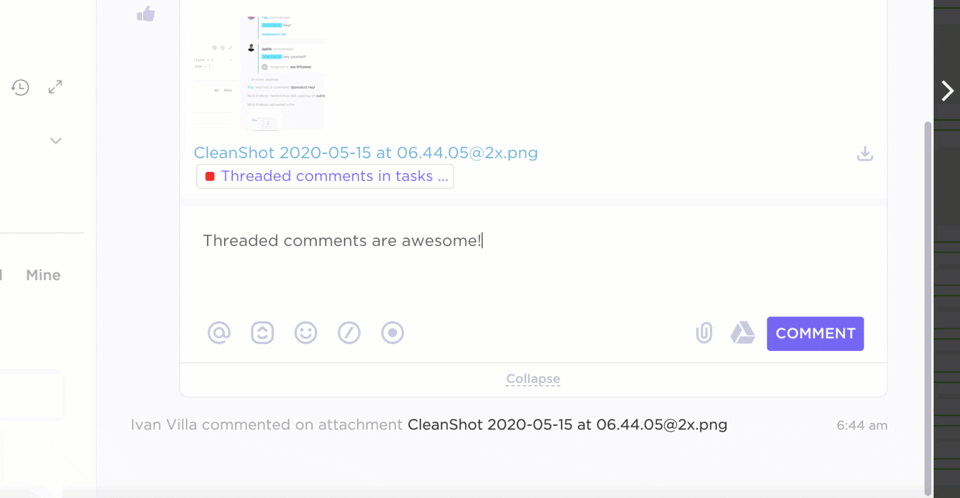
تواصل مع فريقك مباشرة في مهمة ومشاركة المهام الأخرى وتحميل الملفات مع التعليقات المترابطة في ClickUp!
إذا كان رئيسك في العمل يريد صورة أوضح عن حالة المشروع، فإن تقرير حالة إدارة المشروع يوضح كل شيء بالأبيض والأسود لتقليل مخاطر سوء الفهم.
ما يجب تضمينه في تقرير حالة المشروع
بينما تستعد لإنشاء أول تقرير لحالة المشروع، قد تتساءل عما تحتاج إلى تضمينه في التقرير نفسه. أنت لا تريد أن تغفل معلومات مهمة، ولكنك أيضًا لا تريد أن ترهق الجميع بتقرير من 20 صفحة.
حاول أن تحقق التوازن بين مشاركة المعلومات وإبقاء الأمور قصيرة ولطيفة. تأكد من أن تقرير حالة إدارة المشروع الخاص بك يتضمن العناصر الرئيسية التالية. 🔑
ملخص تنفيذي مفصّل - ولكن موجز - ومختصر
يجب أن يقدم الملخص التنفيذي معلومات رفيعة المستوى مع النقاط البارزة في التقرير. هذا هو ملخص المشروع الذي سيطلع عليه مديرك التنفيذي قبل 60 ثانية من اجتماع الحالة؛ لذا لا تتصل به.
على الرغم من أن الملخص يأتي أولاً، إلا أنك تحتاج إلى المعلومات الواردة في بقية التقرير لكتابته. لهذا السبب يجب عليك دائمًا كتابة الملخص التنفيذي أخيرًا.
سيقرأ فريقك التقرير بأكمله إذا أرادوا المزيد من التفاصيل، لذا اجعل الملخص مختصراً - لا يزيد عن ست جمل. ابدأ بـ دليل موثق جيدًا باستخدام قالب حالة المشروع التنفيذي ClickUp .
قالب الملخص التنفيذي
التقدم المرئي للمشروع
يوضح قسم التقدم المحرز تفاصيل حالتك الحالية والمعالم المكتملة و المنجزات . الناس لديهم ذاكرة قصيرة، لذا فإن تذكير الجميع بما أنجزته حتى الآن هو إشارة رائعة إلى العمل الممتاز لفريقك. ✨
هذا هو القسم الذي تتفاخر فيه بإنجازات فريقك. قم باستدعائهم بمخططات جانت الجميلة والرسومات التي تصور إنجازاتك أو أهداف المشروع .
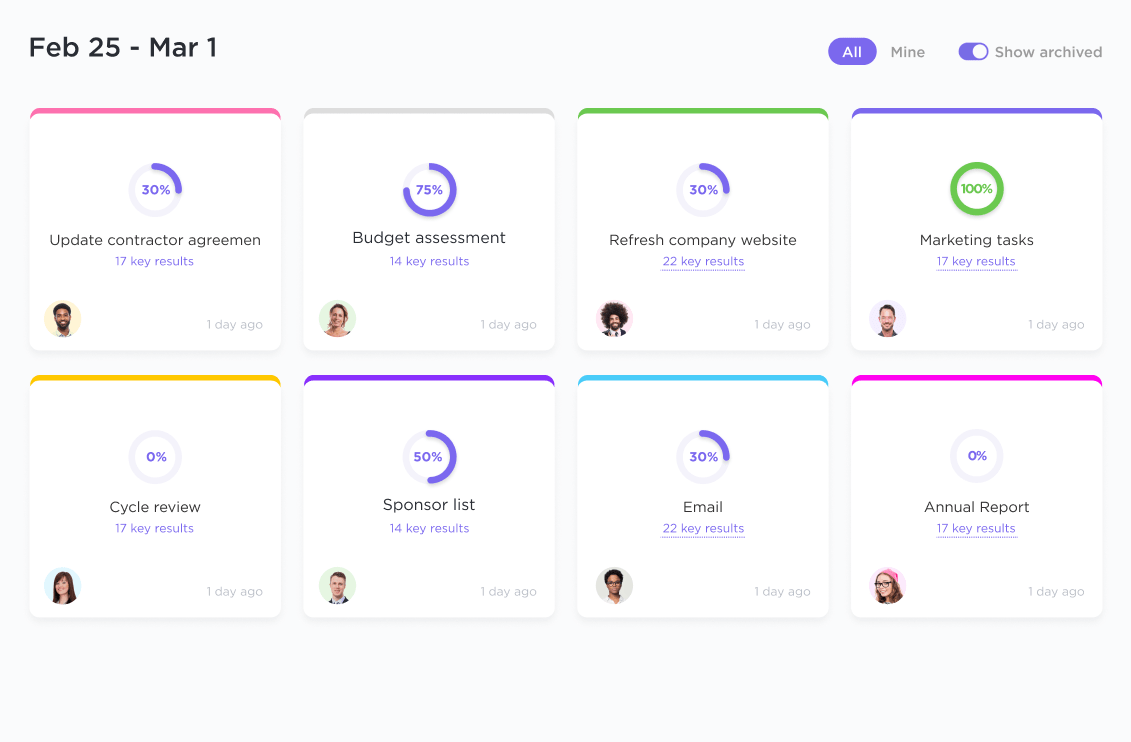
تتبع أهدافك وصولاً إلى مؤشرات الأداء الرئيسية الأكثر أهمية واحصل تلقائيًا على مشاهدات مفصلة عن تقدمك
سيؤدي شريط التقدم أو الرسم البياني الخطي أو المربعات المحددة إلى لفت انتباه رئيسك بالتأكيد إلى الأماكن الصحيحة. يجب أن يلتقط قسم التقدم في تقرير الحالة من التقرير الأخير.
إذا قمت بإنشاء تقارير حالة المشروع على أساس ربع سنوي، فمن السهل أن تنسى أين توقفت. قارن دائمًا تقريرك الحالي بالتقارير السابقة حتى لا تغفل أي شيء.
الجدول الزمني العام للمشروع
قم بجدولة المنشورات الاجتماعية، والمدونات، والإعلانات إلى جانب مهامك واجتماعاتك الأخرى باستخدام عرض التقويم في ClickUp
المشاريع تعيش وتموت حسب المواعيد النهائية. يجب أن تتضمن هذه المنطقة من تقرير حالة المشروع الجدول الزمني العام للمشروع وتوفر تحديثات حول ما وصلت إليه الآن. لاحظ ما إذا كنت متقدمًا على الجدول الزمني أو على المسار الصحيح أو (جرعة) متأخرًا.
بدلاً من سرد الجدول الزمني مع النص، قم بإنشاء لوحة معلومات مرئية أو عرض التقويم أو مخطط جانت لتسهيل استيعاب الأطر الزمنية المعقدة في وقت أقل.
رؤى حول ميزانية المشروع
بعد الوفاء بالمواعيد النهائية ، إدارة الميزانية هي أكبر مسؤولياتك كمدير مشروع. سواءً كان العميل أو الإدارة العليا، يجب أن يحلل تقرير حالة المشروع الخاص بك الأداء المالي للمشروع.
مرة أخرى، حاول تصور ذلك قدر الإمكان. على سبيل المثال، إذا كنت تقوم بإعداد الميزانية على أساس النسب المئوية، فقم بتدوين مقدار ما أنفقته من ميزانية المشروع باستخدام مخطط دائري. استخدم هذا القسم من التقرير أيضًا لتوقع كيف تعتقد أن الإنفاق في الميزانية سيبدو في المستقبل.
التحديات والعوائق الشائعة
ما الذي يعترض طريقك الآن؟ هذه هي فرصتك للتحدث.
فبدلاً من ترك المشاكل بهدوء في الخلفية، قم بالتحدث عنها. على سبيل المثال، إذا لم يزودك العميل بالمعلومات الصحيحة للمشروع، فقم بتدوينها هنا. أو إذا لم يكن لدى فريقك إمكانية الوصول إلى الأدوات المناسبة للمضي قدمًا، فذكرها هنا. 📣
سيجتمع الفريق بأكمله لمراجعة تقرير حالة المشروع، لذا فهذه هي فرصتك للنظر في العوائق ومخاطر المشروع معًا.
الخطوات التالية المعلن عنها بشكل جيد
ما لم تكن قد انتهيت من المشروع بنسبة 100%، ستحتاج إلى توضيح الخطوات التالية. في هذا القسم من تقرير حالة المشروع، وضح المهام والمعالم التي لا تزال بحاجة إلى إكمالها.
لكن لا تكتفِ بسرد المهام. أضف لمسة من المساءلة من خلال تعيين الخطوات التالية لأعضاء فريق محددين، إلى جانب تواريخ الاستحقاق. وبهذه الطريقة، يكون لديك مسار واضح جدًا للمضي قدمًا - بالإضافة إلى المساءلة - حتى لا يتساءل أحد عن مسؤوليته.
كل مؤشرات الأداء الرئيسية للمشروع والمقاييس
أخيرًا، يجب أن يتضمن كل تقرير عن حالة المشروع قسمًا للمقاييس فقط. لك مطلق الحرية في نسج هذه المقاييس في جميع أنحاء التقرير، ولكن حتى في هذه الحالة، قد يرغب بعض الأشخاص في رؤية عرض رفيع المستوى لأداء المشروع في مكان واحد.
إدراج مقاييسك في قسم واحد يجعل من الممكن مراقبتها بمرور الوقت. انظر إلى المتوسطات على مدار المشروع، بالإضافة إلى كيفية مقارنة هذا التقرير بالتقارير السابقة، لمعرفة ما إذا كنت على المسار الصحيح.
يختلف كل مشروع عن الآخر، ولكن من الجيد تتبع مقاييس مثل:
- أداء التكلفة
- الوقت المسجل
- الهوامش الإجمالية
- رضا العملاء
- الإنتاجية
- إنجاز تاريخ الاستحقاق بنجاح
كلما قللت من جعل هذا يبدو كجدار من الأرقام المملة، كان ذلك أفضل. استخدم قالب تقرير المشروع مع رسومات جميلة لإبراز مقاييسك.
إنشاء تقارير حالة المشروع بنقرة واحدة
الإدارة الناجحة للمشروع هي فن من الفنون. قد يبدو لرئيسك في العمل أن كل شيء يسير بسلاسة، لكن تقرير حالة المشروع يُظهر مقدار العمل الذي بذلته أنت وفريقك لتحقيق ذلك. 🎨
اجعل فريقك على نفس الصفحة، وطمأن أصحاب المصلحة، وأنشئ المزيد من التنظيم خطط المشروع مع نموذج تقرير حالة المشروع
في حين أن القوالب بداية جيدة، إلا أنها لا تزال بحاجة إلى بيانات. ClickUp Dashboards قم بتسريع التقارير من خلال ربط مركز التحكم في مهمة المشروع بالتقارير والقوالب والمحادثات وغير ذلك الكثير.
أنشئ تقرير الحالة التالي في ClickUp: أنشئ لوحة التحكم الخاصة بك الآن- إنه مجاني للأبد !


